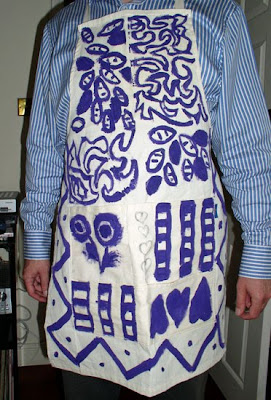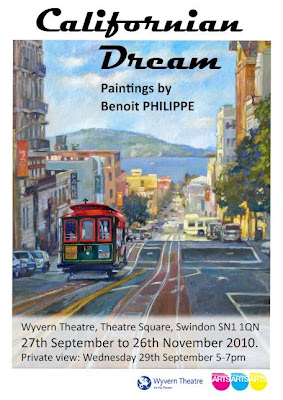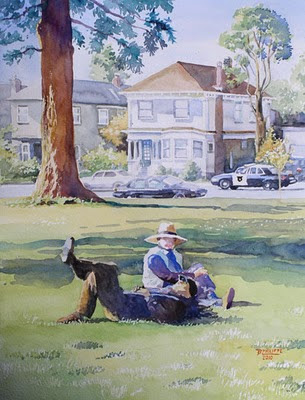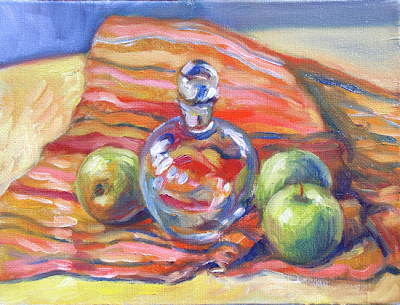
Thursday, 26 August 2010
Summer read - how to be creative by Hugh MacLeod

Monday, 23 August 2010
Four lemons - oil painting
Thursday, 19 August 2010
My unique painting apron

Monday, 16 August 2010
Sitting on the dock of the bay
I chose the title of this painting in homage to Otis Redding whose “Sitting on the dock of the bay” is one of my favourite songs.

Sitting on the dock of the bay - oil on linen canvas (50 x 60 cm) by Benoit Philippe
And as it happens, the lyrics fit very well what was happening this morning, as I was walking along the docks, on my way to Pier 39:
I left my home in Georgia
Headed for the 'Frisco bay
'Cause I've had nothing to live for
And look like nothin's gonna come my way
So I'm just gonna sit on the dock of the bay
Watching the tide roll away
Ooo, I'm sittin' on the dock of the bay
I walked all the way to the end of Pier 7. It was early morning and I was alone, apart from some amateur fishermen. There was no fog, I was lucky; but the wind was strong.
When I came back, I saw this man with his trolley. All his possessions were stacked on that trolley, secured with ropes. And he was watching San Francisco Bay, the light sparkling on the water, the boats and Bay Bridge in the background.
I wanted to do a painting using mainly greys. This was an ideal subject for it with the backlit man, the railing and the strong shadows.
I started using greys, black and white. The result was dull. So I decided to play on the contrast between blue and yellow and use greys tinted with both tones. The painting is mainly in the cool spectrum. The only warm colour I used was a Naple Yellow Reddish colour.
Here is the full palette I used for this painting:
- Titanium White (Griffin Alkyd – Winsor & Newton)
- Naple Yellow Reddish (Rembrandt)
- Cadmium Yellow Pale (Winsor & Newton)
- Davy’s Grey (Winsor & Newton)
- Payne’s Grey (Mussini / Scmincke)
- Cobalt Blue Tone (Mussini / Scmincke)
- Ultramarine Blue
Oil painting San Francisco Pier 7 Bay Bridge Californian Dream exhibition
Thursday, 12 August 2010
Californian Dream exhibition

- 27th September to 26th November 2010.
- Private view: Wednesday 29th September 5-7pm
- Wyvern Theatre, Theatre Square, Swindon SN1 1QN - 01793 524 481
Wednesday, 11 August 2010
Luminous shadows in watercolour
This article was first published in "Frequency Magazine"– August 2010.
The expression “luminous shadow” seems a paradox or, to be precise, an oxymoron. Are shadows supposed to be the absence of light? How a shadow could be luminous?
As usual, reality is more complex than we think and if you observe carefully shadow areas, you will find reflected lights in them.
Recently, I was painting a watercolour from a reference photograph I took on a trip to California. A sequoia was framing the scene on the left in a beautiful way, but the tree trunk was just a big black mass on the photograph because the weather was sunny when the photograph was shot and digital cameras tend to exaggerate extreme values and loose details in shadows.

Nap time at Willard Park - Watercolour (31 cm x 39 cm) by Benoit Philippe
The problem I had to solve was: how to avoid a black and dull shadow and still convey the idea of bright lights and strong shadows.
I knew I had to make the shadow lighter; otherwise it would overpower the rest of the composition. A very dark element in the foreground of a composition can work as a “repoussoir” (French painters of the classic era used this trick and framed their painting with dark foliage to push further away the lighter area in a landscape and make it more striking). The tree in my landscape was in the middle ground and I did not want it to win over my main subject.
One way to keep a good contrast between the shadow and light areas while avoiding having too dark shadows is to use a higher key for the whole painting. By this I mean that if the surrounding elements are executed in a lighter tone (with lighter values), then the shadows can still appear as such, even though I am not using very dark tones. Watercolour is an ideal medium for this as it is easy to obtain lighter and subtle washes just by adding more water to your colours. You can start light and build-up colour intensity and tone with successive washes. This way, you can adjust the balance until you get it right.
The use of simultaneous contrasts within the object itself helps reinforcing the impression given by the shadow. In this case, I drew highlights on the bark with some masking fluid where the light was caught on the sculptural bark of the tree. Masking fluid creates sharp edges that contribute to the effect of much contrasted lights and shadows.
Another type of simultaneous contrast I like to use is the one between complimentary colours. For a tree trunk, if the light is yellow-orange, then I can use some blue-violet in the shadow. This makes both colours sing, not only the lighter one.
I also wanted to make the shadow colourful in order to contrast it with the background, mainly handled with a range of coloured greys. Here is the secret of a “glowing shadow”: I applied a first wash of Yellow Ochre on the whole trunk. I let it dry and only then applied a reddish purple, mixed with Alizarin Crimson and Ultramarine Blue. Both colours are transparent and therefore the Yellow Ochre underpainting showed through. It was like having some of the light glowing underneath the shadow. It also gave a greater unity to the tree trunk because of the continuity of the Yellow Ochre, even under the shadow area.
Painting technique Watercolour Watercolor Painting shadows
Monday, 9 August 2010
The making of Morning fog in San Francisco
While painting “Morning fog in San Francisco”, I stopped many times to take photographs of the work in progress.
I put the sequence of photographs into a slideshow that you can now watch it as a YouTube video.
Note: if you are in the office, turn the sound down or put your headset on. There is some music in the video.
If you cannot see correctly the embedded video, click on it to see it in or YouTube follow the link to The making of Morning fog in San Francisco video on YouTube.
painting demonstration oil painting YouTube art demo Step by step painting Californian dream exhibition Wyvern Theatre Swindon
Sunday, 1 August 2010
Painting glass
Beginners are often afraid of painting glass. It seems a daunting task to render the transparency, the reflected lights and shadows and convey the volume at the same time. In a still life, glassware objects create interesting texture and fill the space in a lighter way thanks to their transparency; so your effort will be rewarded.
The first step consists in careful observation. Glass has in general no colour (although it is sometimes slightly blue or green). The colour is determined by the surrounding, the background and the reflected objects. Observation is fundamental: move objects around the glass object you want to paint and see how it affects the pattern of colours and lights on the glass.

All round - oil on panel (6" x 8") by Benoit Philippe
If the glass object is round, the reflected light follows the curve of the object. Shaped glass objects will distort objects placed behind them. If the object is only in part behind the glass object, it can create a broken line at the periphery of the glass object.
The second step in painting glass object is to isolate issues and simplify your approach.
It is easier to paint glass against a dark background because the effect of the light through the glass is more obvious. It is also easier when the background is plain rather than patterned because you can concentrate on tones without worrying about the changes of colours.
It is better, when you start, to have a fixed source of light. This is possible if you set-up your still life subject in your studio and use a lamp.
The aspect of the glass will change if you move around it. Even a slight move on your left or your right may be sufficient to change the colour patterns. For this reason it is easier to use photographs at the beginning in order to understand the play of reflected colours. This way, you will avoid the variations you get when you move.
Tone is the most relevant information to convey the transparency and reflection on glass. A good way to get a grip on the “glass effect” is to start by doing some pencil drawings and then a monochrome paintings.
When I paint glassware in oil, for the preliminary drawing, I prefer to draw only the overall shape of the object and then paint directly the shapes within the glass objects. Some hyper-realist painters start by drawing all the reflection, shapes, etc. (sometime by tracing them from a photograph). I found that the result with this method looks too mechanical and artificial for my taste.
I would then build-up the glass as I paint the background. This way, I get background colours seen by transparency. Because of the transparency, some parts of the glass will disappear into the background. This effect would be much more difficult if you decided to paint the background first, reserving the glass object, and then painted the glass object once the background had dried. There are good chances that the glass would look like an afterthought.
To create the pattern of light and shadows in the glass, I paint the coloured shape rather than each single line. The trick is to simplify the shapes. If you are not sure of the way to go, squinting at your subject will help to remove unnecessary details.
Glassware objects present a mix of soft edges and sharp edges. Glass is only visible if there is some light on it. It is therefore possible to have a lost edge in the side of a glass object in the shadow. I like to work wet in wet as far as I can. Glazing white on top, when the first stage is dry, is a good way to indicate the shine on the surface of the glass.
Once you master the basics of painting glass object, you have several ways to add interest: place a coloured object behind the glassware; have a background with changing colours or patterns; vary the degree of light on the glass object; use pieces of glassware with facets (each facet will have its own reflection due to different orientations; or place a laced pattern under the glass.

